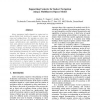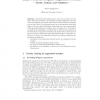42 search results - page 2 / 9 » Modelling Navigational Knowledge by Route Graphs |
MDM
2009
Springer
14 years 5 days ago
2009
Springer
Indoor navigation highly depends on context and requires flexible data structures to support the many use cases and configurations. For example, an indoor navigation system must c...
ESA
2007
Springer
13 years 11 months ago
2007
Springer
Abstract. The small world phenomenon, a.k.a. the six degree of separation between individuals, was identified by Stanley Milgram at the end of the 60s. Milgram experiment demonstr...
SPATIALCOGNITION
2004
Springer
13 years 11 months ago
2004
Springer
Abstract. In this paper we apply a formal ontological framework in order to deconstruct two prominent approaches to navigation from cognitive robotics, the Spatial Semantic Hierarc...
CORR
2007
Springer
13 years 5 months ago
2007
Springer
Graphs are called navigable if one can find short paths through them using only local knowledge. It has been shown that for a graph to be navigable, its construction needs to mee...
CORR
2008
Springer
13 years 5 months ago
2008
Springer
Abstract. We propose a dynamic process for network evolution, aiming at explaining the emergence of the small world phenomenon, i.e., the statistical observation that any pair of i...


